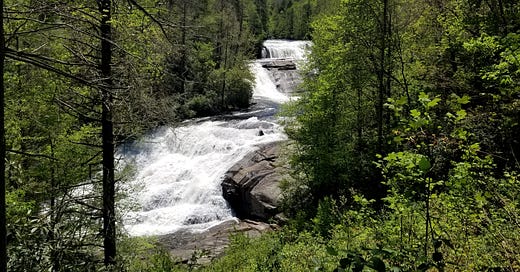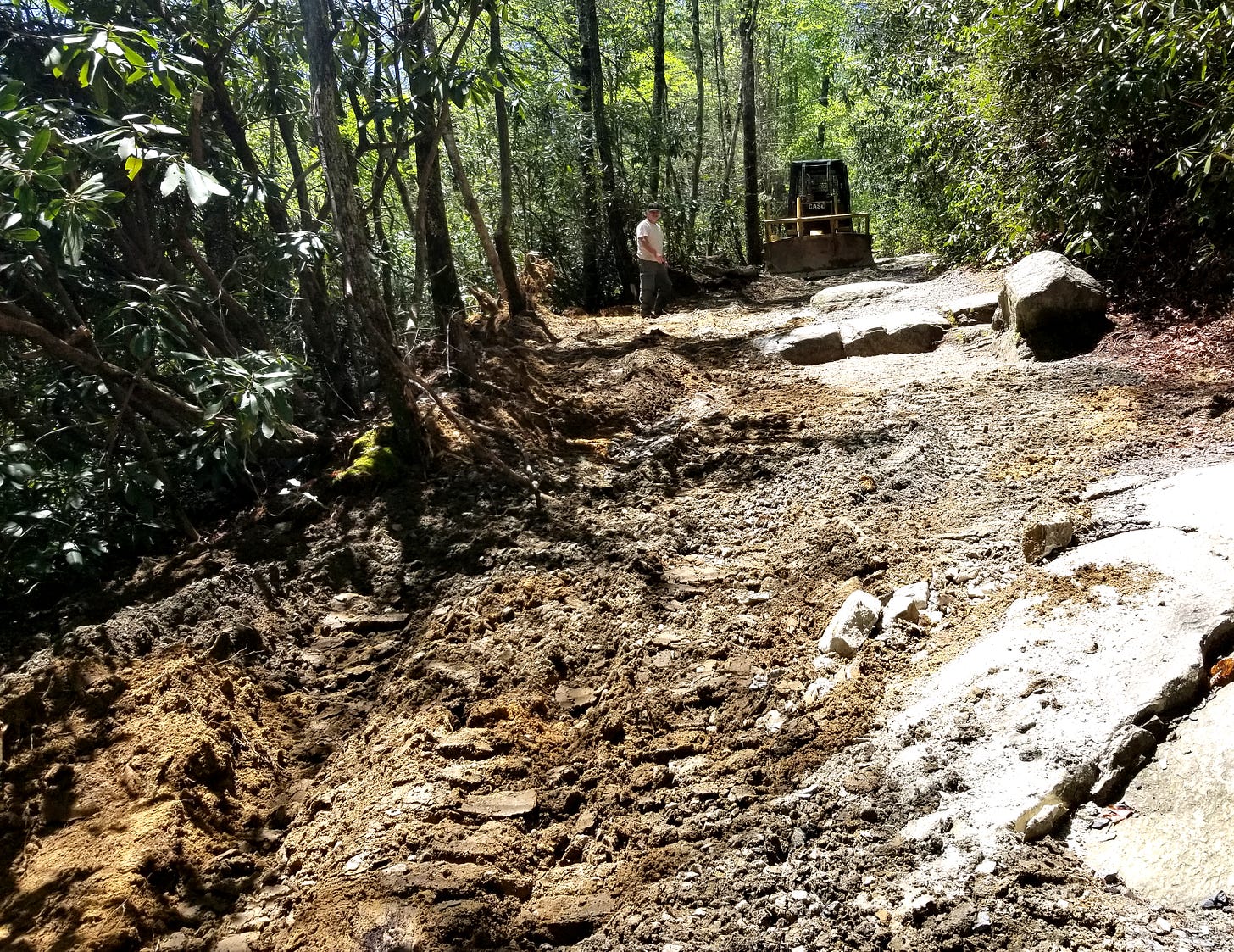Temporary closures and long-term plans: DuPont works to accommodate "huge surge" of visitors during the Covid-19 pandemic and maybe beyond
Parts of Triple Falls Trail face temporary closures this month to address design flaws and the impact of heavy rains and foot traffic. Long-term plans are "to be determined."
By Dan DeWitt
Brevard NewsBeat
Jane Dauster, a recreational specialist at DuPont State Recreational Forest, opened a cell-phone map and pointed to dashes representing the rhododendron-lined path she was standing on, Triple Falls Trail.
A modern, well-conceived route would follow the contour lines as much as possible, she explained. The current trail, built decades ago to allow close-up views of Little River and its series of landmark cascades, cuts straight across them, climbing a grade of more than 20 percent.
“It’s going to fail epically,” she said of the trail, “and that’s what’s going on.”
This antiquated design is the underlying reason the trail will be closed for repair through Friday, maybe part of next week, and, likely, later in May for improvements to the path’s upper section.
Another cause of the damage to the trail is beyond the control of the forest management — rainfall totals that could also be called “epic,” more than 120 inches in each of the last two years, Dauster said
The third reason, on the other hand, is a major driver of forest policy and will be in the future, said Christie Adams, spokeswoman for the North Carolina Forest Service.
That is the wear on trails and other facilities caused by the surge in visitation to the forest during the Covid-19 pandemic, and the possibility that these crowds will continue to grow even as restrictions ease.
“There were so few places people could go, and that created this huge surge to outdoor spaces,” she said. “Once the restrictions are lifted, are people going to veer away from public lands? I don’t know. I think that’s a ‘to be determined,’ ” she said.
DuPont, long one of the region’s most popular outdoor destinations, saw visitation jump to 1.1 million in 2020, despite being closed for two months as the pandemic took hold last spring.
That was a 20 percent increase from the year before, which itself saw a 13 percent increase in visitation from 2018.
The jumps have been dramatic enough that DuPont’s management has had to adjust to accommodate the crowds and may ultimately face the question of whether the 12,400-acre forest is simply attracting more people than it can handle.
“I think that’s a fair statement,” Adams said, though she added that as publicly owned property, the Forest should be as accessible as possible and that the Service has few options for limiting crowds.
Whatever the impact of Covid-19, these crowds will definitely grow during the peak summer season, which the Forest Service has been preparing for since February.
Along with the upgrading of Triple Falls Trail, Forest managers temporarily closed the Hooker Falls, Lake Imaging and High Falls access areas during the offseason to resurface, and in some cases, reorganize parking lots, including the addition of dedicated equestrian parking.
The Forest is also looking at the possibility of extending the elimination of parking on Staton Road, which was implemented during the pandemic.
This was put in place partly “because (roadside parking) was completely unsafe because of the volume of people,” Adams said.
With “vehicles parked half on the road and half off the road, you essentially had pedestrians walking in the middle of what was (no wider than) a one-way street,” she said.
Roadside parking also provided capacity for so many visitors that trails became too packed to allow for social distancing, she said, and going forward, this restriction may be one of the only options to not only ensure visitor safety, but to limit crowds.
“It is public land. It is open. There is no entry gate, no single point of admission,” she said. “At this point, we have not established a time when, or if, that roadside exclusion will be removed.”
But neither this limit nor the closures of Triple Falls Trail should discourage visitors wanting to see the Forest’s most popular sights, she said.
They will still be able to access Triple Falls from the High Falls Access Area, she said. And though they may have to move their cars or backtrack on trails to include a trip to Hooker Falls, that feature will also remain accessible, she said.
She encouraged anyone planning a visit to check the Forest’s website for closures and progress on the work that that will create a stable, walkable path — at least for the next few years, Dauster said.
Long-term, the Forest must consider more extensive improvements to Triple Falls Trail, either stone stairs that would have the disadvantage of limiting access for rescue vehicles, Dauster said, or planning a new, more sustainable route with switchbacks following the contours of the land. Because of the ecological sensitivity of the surrounding forest, she said, building this path would be time-consuming and “uber-complicated.”
Meanwhile, she pointed to a series of undulations formed by heavy equipment operator Jimmy Patterson. These “water bars or rolling-grade dips,” Dauster said on Wednesday, will impede fast-flowing water and control erosion.
But they will not hold up forever in the face of the Forest’s heavy rains — or the foot traffic of its mass of visitors.
“It’s kind of a Band-Aid,” she said.





